Paper Menu >>
Journal Menu >>
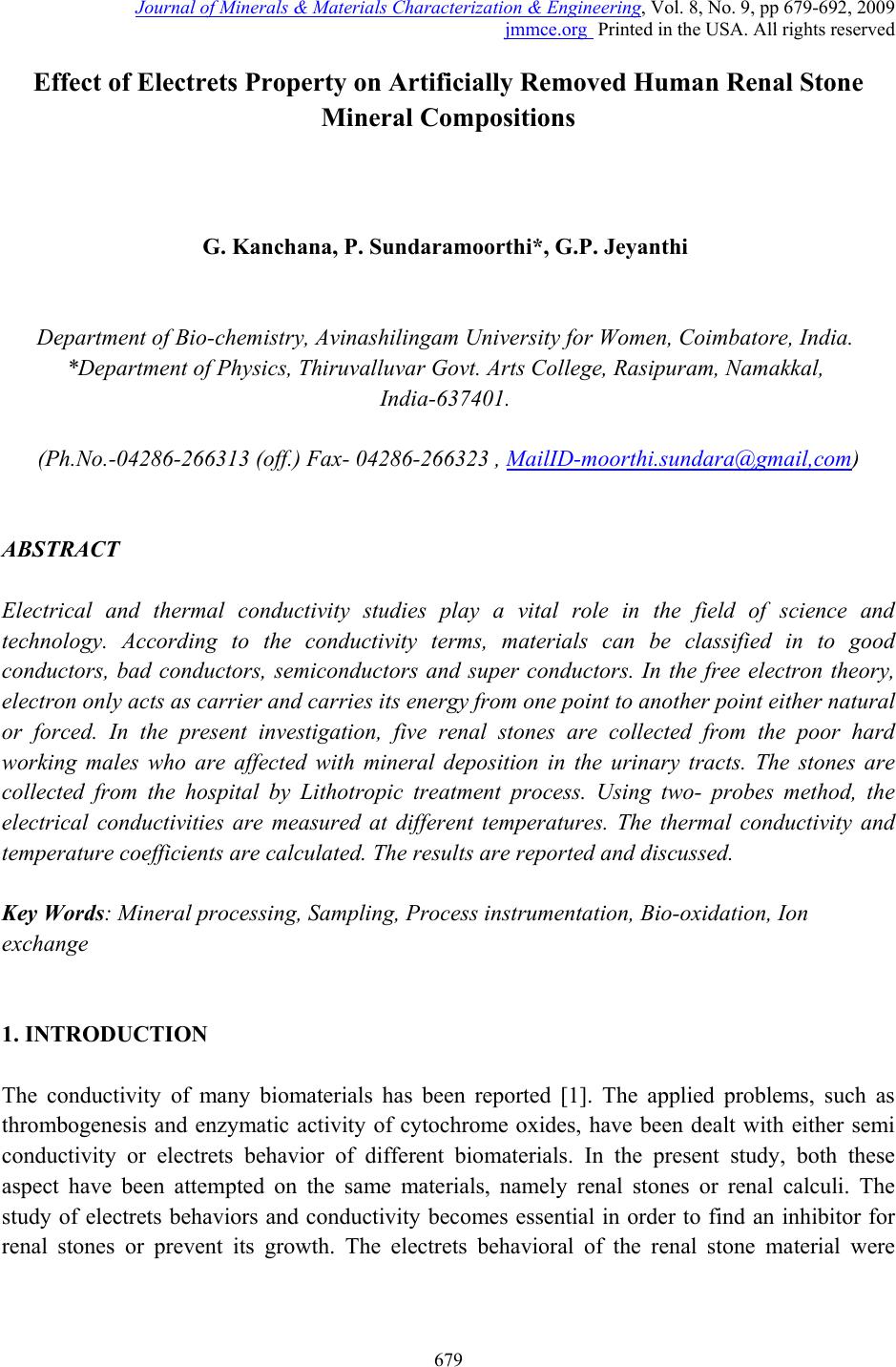 Journal of Minerals & Materials Characterization & Engineering, Vol. 8, No. 9, pp 679-692, 2009 jmmce.org Printed in the USA. All rights reserved 679 Effect of Electrets Property on Artificially Removed Human Renal Stone Mineral Compositions G. Kanchana, P. Sundaramoorthi*, G.P. Jeyanthi Department of Bio-chemistry, Avinashilingam University for Women, Coimbatore, India. *Department of Physics, Thiruvalluvar Govt. Arts College, Rasipuram, Namakkal, India-637401. (Ph.No.-04286-266313 (off.) Fax- 04286-266323 , MailID-moorthi.sundara@gmail,com) ABSTRACT Electrical and thermal conductivity studies play a vital role in the field of science and technology. According to the conductivity terms, materials can be classified in to good conductors, bad conductors, semiconductors and super conductors. In the free electron theory, electron only acts as carrier and carries its energy from one point to another point either natural or forced. In the present investigation, five renal stones are collected from the poor hard working males who are affected with mineral deposition in the urinary tracts. The stones are collected from the hospital by Lithotropic treatment process. Using two- probes method, the electrical conductivities are measured at different temperatures. The thermal conductivity and temperature coefficients are calculated. The results are reported and discussed. Key Words: Mineral processing, Sampling, Process instrumentation, Bio-oxidation, Ion exchange 1. INTRODUCTION The conductivity of many biomaterials has been reported [1]. The applied problems, such as thrombogenesis and enzymatic activity of cytochrome oxides, have been dealt with either semi conductivity or electrets behavior of different biomaterials. In the present study, both these aspect have been attempted on the same materials, namely renal stones or renal calculi. The study of electrets behaviors and conductivity becomes essential in order to find an inhibitor for renal stones or prevent its growth. The electrets behavioral of the renal stone material were 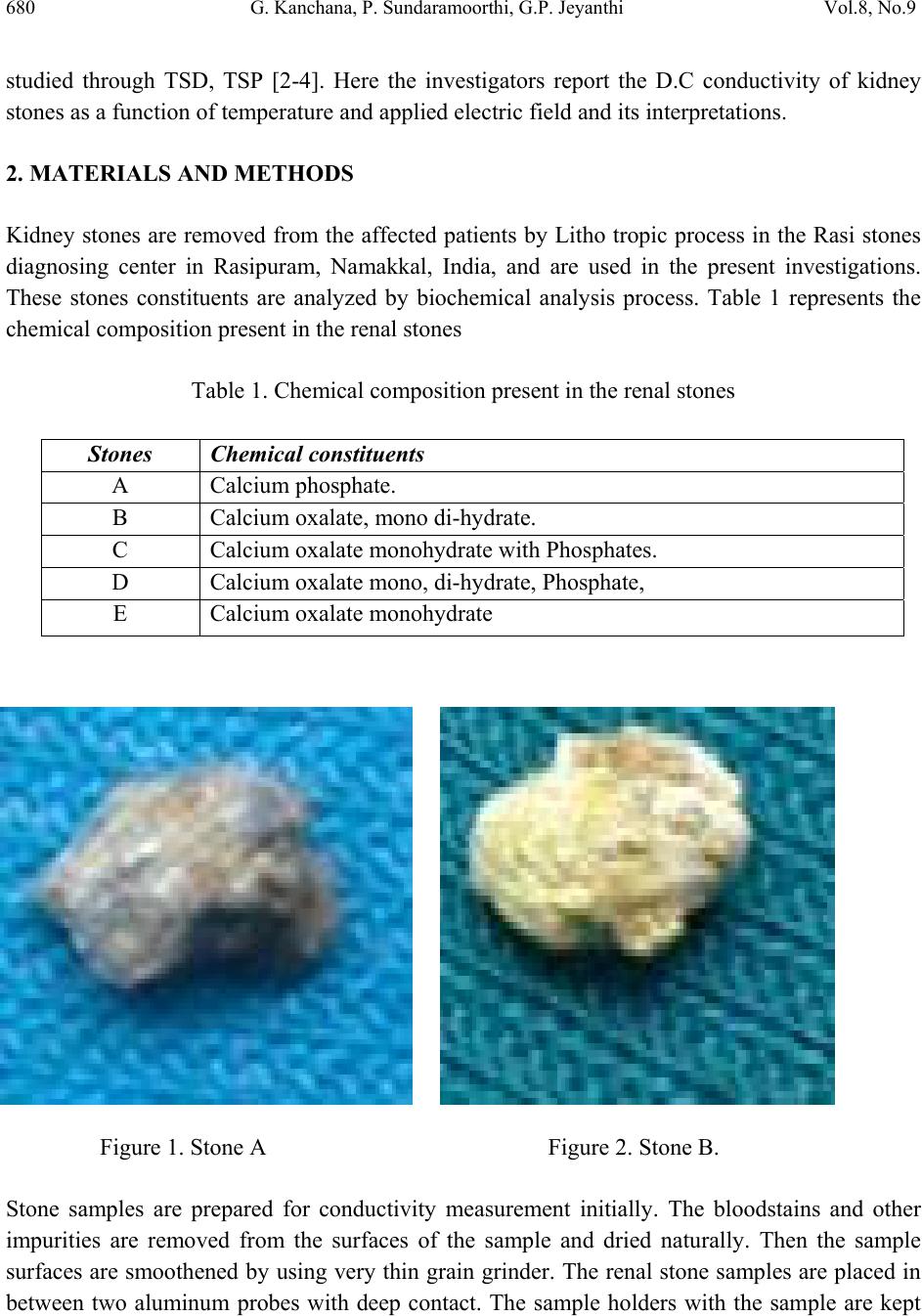 680 G. Kanchana, P. Sundaramoorthi, G.P. Jeyanthi Vol.8, No.9 studied through TSD, TSP [2-4]. Here the investigators report the D.C conductivity of kidney stones as a function of temperature and applied electric field and its interpretations. 2. MATERIALS AND METHODS Kidney stones are removed from the affected patients by Litho tropic process in the Rasi stones diagnosing center in Rasipuram, Namakkal, India, and are used in the present investigations. These stones constituents are analyzed by biochemical analysis process. Table 1 represents the chemical composition present in the renal stones Table 1. Chemical composition present in the renal stones Stones Chemical constituents A Calcium phosphate. B Calcium oxalate, mono di-hydrate. C Calcium oxalate monohydrate with Phosphates. D Calcium oxalate mono, di-hydrate, Phosphate, E Calcium oxalate monohydrate Figure 1. Stone A Figure 2. Stone B. Stone samples are prepared for conductivity measurement initially. The bloodstains and other impurities are removed from the surfaces of the sample and dried naturally. Then the sample surfaces are smoothened by using very thin grain grinder. The renal stone samples are placed in between two aluminum probes with deep contact. The sample holders with the sample are kept 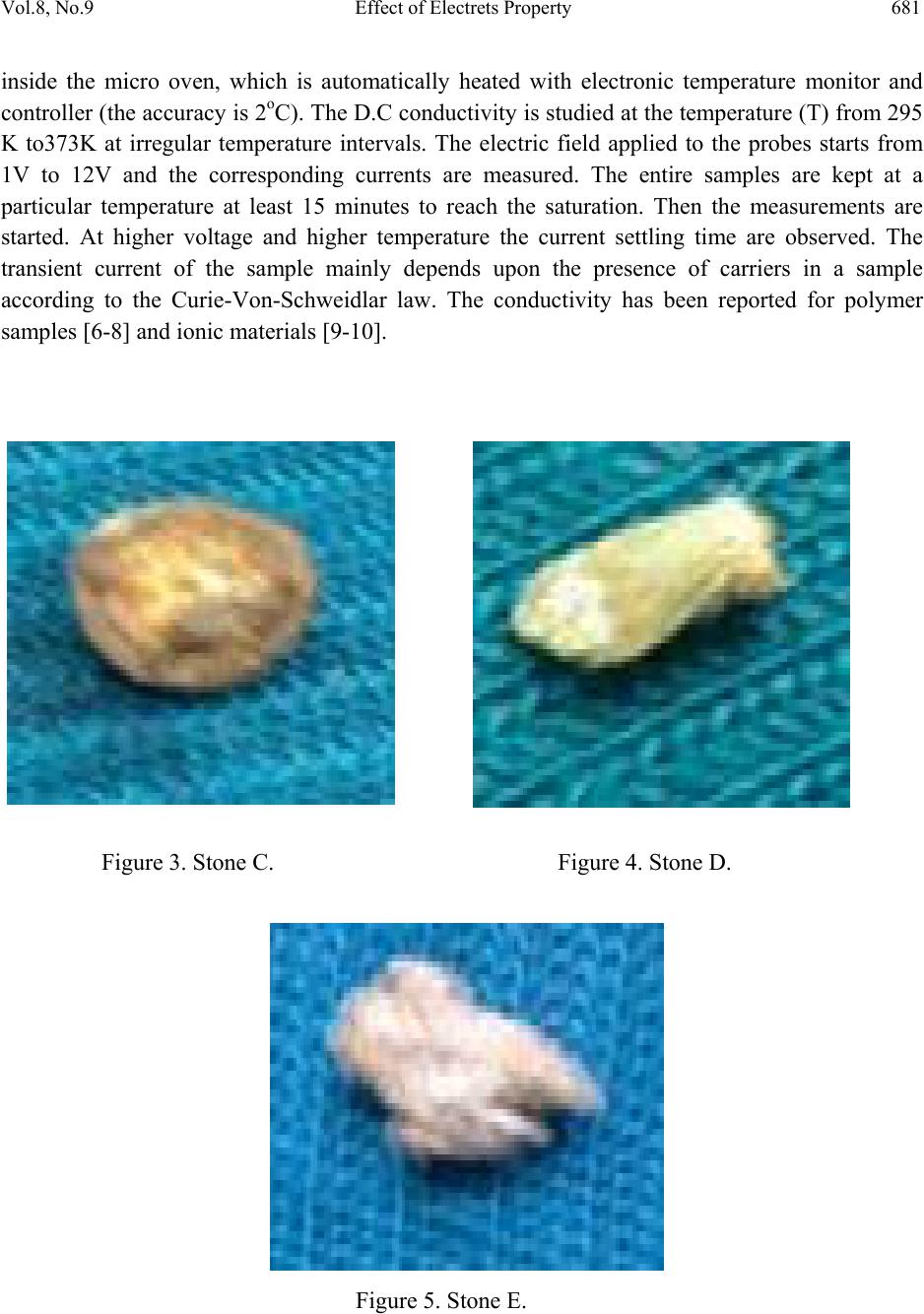 Vol.8, No.9 Effect of Electrets Property 681 inside the micro oven, which is automatically heated with electronic temperature monitor and controller (the accuracy is 2oC). The D.C conductivity is studied at the temperature (T) from 295 K to373K at irregular temperature intervals. The electric field applied to the probes starts from 1V to 12V and the corresponding currents are measured. The entire samples are kept at a particular temperature at least 15 minutes to reach the saturation. Then the measurements are started. At higher voltage and higher temperature the current settling time are observed. The transient current of the sample mainly depends upon the presence of carriers in a sample according to the Curie-Von-Schweidlar law. The conductivity has been reported for polymer samples [6-8] and ionic materials [9-10]. Figure 3. Stone C. Figure 4. Stone D. Figure 5. Stone E.  682 G. Kanchana, P. Sundaramoorthi, G.P. Jeyanthi Vol.8, No.9 3. RESULTS The approximate area of each samples are measured by using graph sheet. The temperatures are varied from 295K to 373 K. The applied voltage (V), corresponding current measurements (I), resistance (R), resistivity (ρ), conductivity (σ) and current density (J) of each sample at a particular temperature are reported in Tables 2 to 16. Table 2. Electrets properties of renal stone A at 33oC, A=30x10-6 m2, L=5x10-3m S.NO Voltage applied in Volts (V). Current measured in micro -amperes (I). Resistance 106 (Ohm). Resistivity in Ohm. m (ρ). Current density (J) x 10-4 Amp/m2 1 2 3 0.667 3960 0.5052 2 4 3 1.333 7980 0.5013 3 6 4 1.500 9000 0.6670 4 8 5 1.600 9600 0.8333 5 10 6 1.667 1002 0.9999 6 12 8 1.500 9000 1.3333 1.378 8257 0.8060 Co efficient of electrical conductivity (σ) = 1.211x10-4 mho.m-1 Table 3. Electrets properties of renal stone A at 62°C, A=30x10-6 m2, L=5x10-3m S.NO Voltage applied in Volts (V). Current measured in micro -amperes (I). Resistance in 106 (Ohm). Resistivity in Ohm. m (ρ). Current density (J) x 10-4 Amp/m2 1 2 2 1.000 6000 0.3333 2 4 2 2.000 12000 0.3333 3 6 3 2,000 12000 0.3333 4 8 4 2.000 12000 0.3333 5 10 5 2.000 12000 0.3333 6 12 6 2.000 12000 0.3333 2.000 11000 0.3333 Co efficient of electrical conductivity (σ) =0.909x10-4 mho.m-1 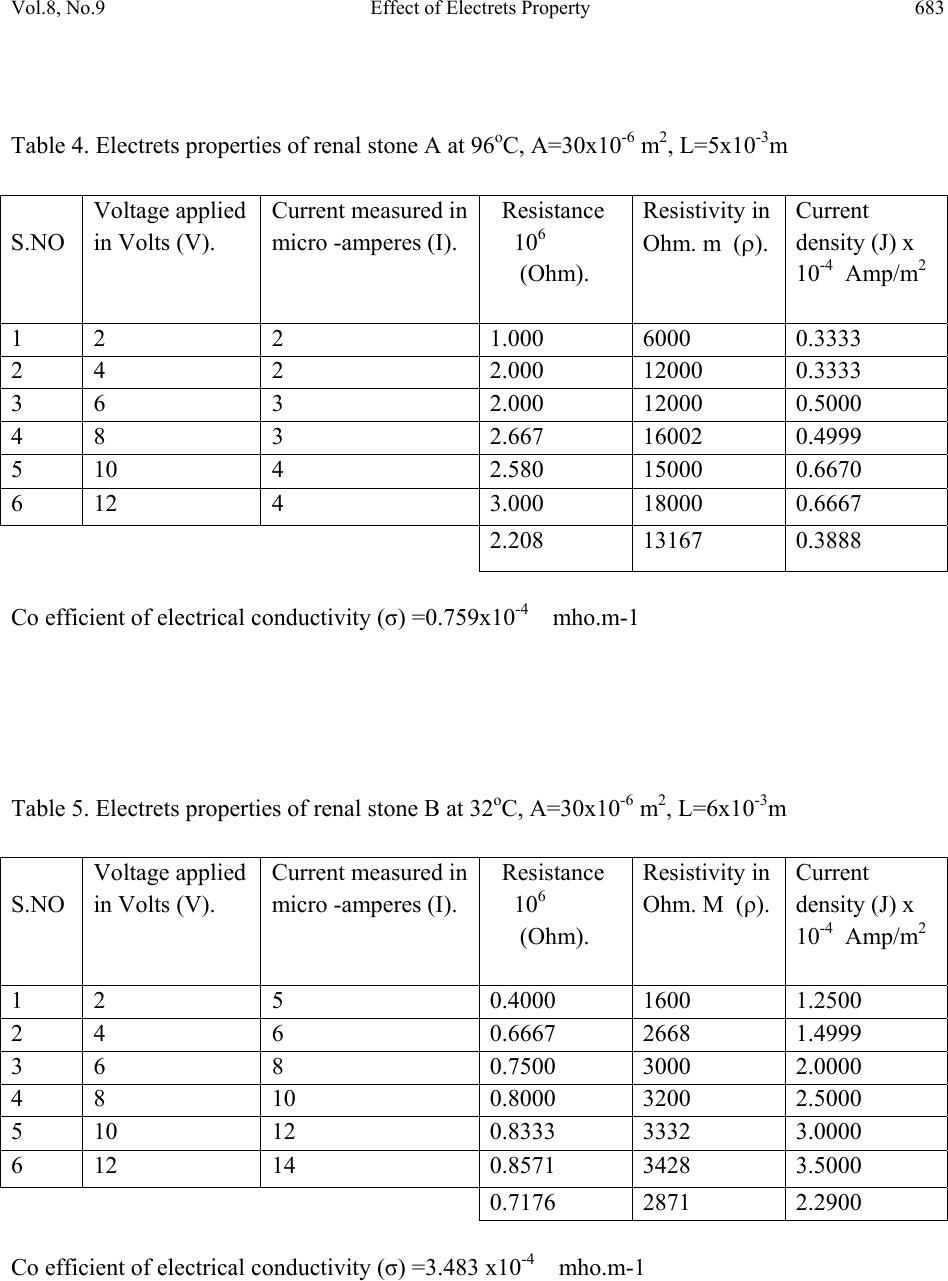 Vol.8, No.9 Effect of Electrets Property 683 Table 4. Electrets properties of renal stone A at 96oC, A=30x10-6 m2, L=5x10-3m S.NO Voltage applied in Volts (V). Current measured in micro -amperes (I). Resistance 106 (Ohm). Resistivity in Ohm. m (ρ). Current density (J) x 10-4 Amp/m2 1 2 2 1.000 6000 0.3333 2 4 2 2.000 12000 0.3333 3 6 3 2.000 12000 0.5000 4 8 3 2.667 16002 0.4999 5 10 4 2.580 15000 0.6670 6 12 4 3.000 18000 0.6667 2.208 13167 0.3888 Co efficient of electrical conductivity (σ) =0.759x10-4 mho.m-1 Table 5. Electrets properties of renal stone B at 32oC, A=30x10-6 m2, L=6x10-3m S.NO Voltage applied in Volts (V). Current measured in micro -amperes (I). Resistance 106 (Ohm). Resistivity in Ohm. M (ρ). Current density (J) x 10-4 Amp/m2 1 2 5 0.4000 1600 1.2500 2 4 6 0.6667 2668 1.4999 3 6 8 0.7500 3000 2.0000 4 8 10 0.8000 3200 2.5000 5 10 12 0.8333 3332 3.0000 6 12 14 0.8571 3428 3.5000 0.7176 2871 2.2900 Co efficient of electrical conductivity (σ) =3.483 x10-4 mho.m-1 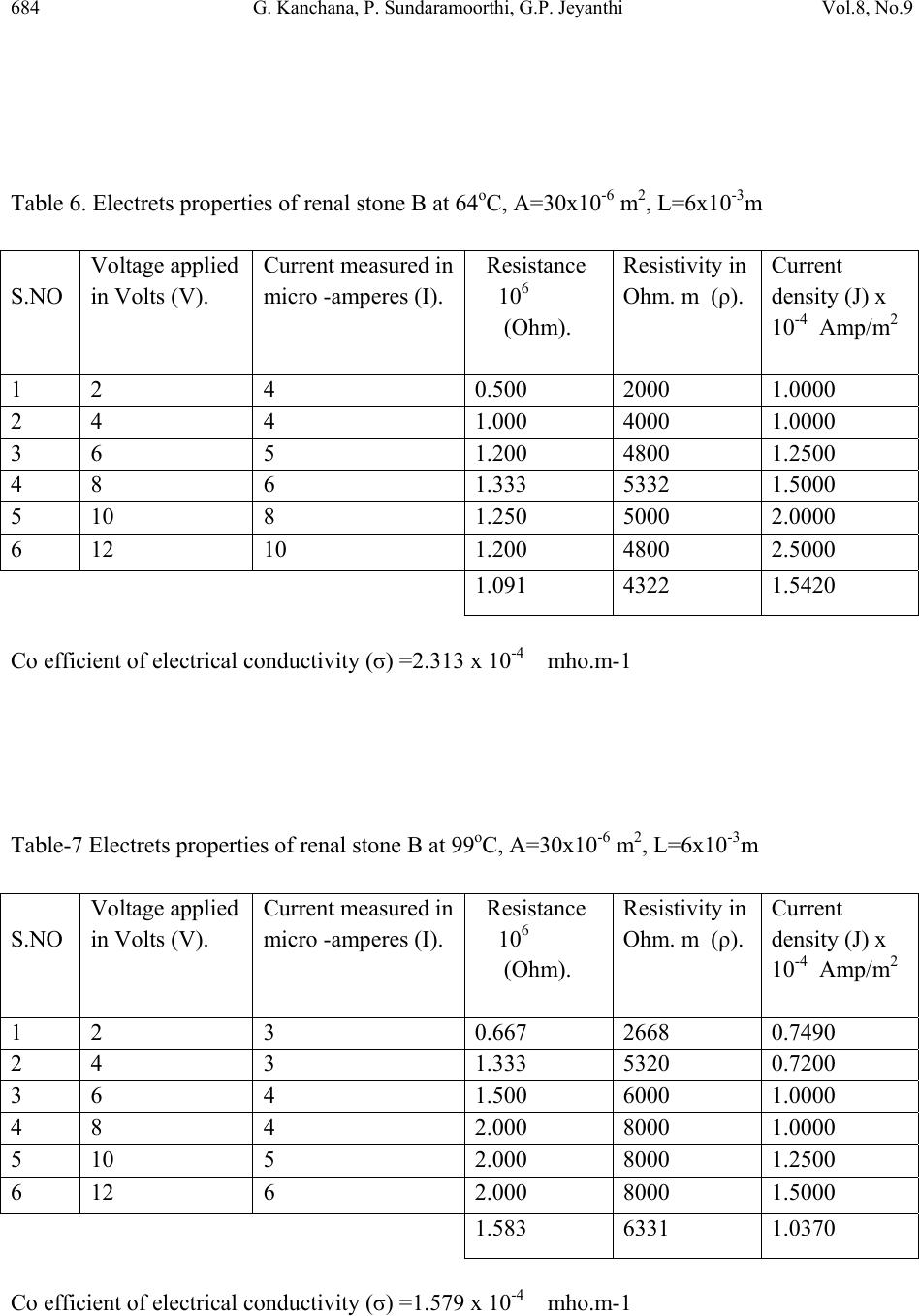 684 G. Kanchana, P. Sundaramoorthi, G.P. Jeyanthi Vol.8, No.9 Table 6. Electrets properties of renal stone B at 64oC, A=30x10-6 m2, L=6x10-3m S.NO Voltage applied in Volts (V). Current measured in micro -amperes (I). Resistance 106 (Ohm). Resistivity in Ohm. m (ρ). Current density (J) x 10-4 Amp/m2 1 2 4 0.500 2000 1.0000 2 4 4 1.000 4000 1.0000 3 6 5 1.200 4800 1.2500 4 8 6 1.333 5332 1.5000 5 10 8 1.250 5000 2.0000 6 12 10 1.200 4800 2.5000 1.091 4322 1.5420 Co efficient of electrical conductivity (σ) =2.313 x 10-4 mho.m-1 Table-7 Electrets properties of renal stone B at 99oC, A=30x10-6 m2, L=6x10-3m S.NO Voltage applied in Volts (V). Current measured in micro -amperes (I). Resistance 106 (Ohm). Resistivity in Ohm. m (ρ). Current density (J) x 10-4 Amp/m2 1 2 3 0.667 2668 0.7490 2 4 3 1.333 5320 0.7200 3 6 4 1.500 6000 1.0000 4 8 4 2.000 8000 1.0000 5 10 5 2.000 8000 1.2500 6 12 6 2.000 8000 1.5000 1.583 6331 1.0370 Co efficient of electrical conductivity (σ) =1.579 x 10-4 mho.m-1 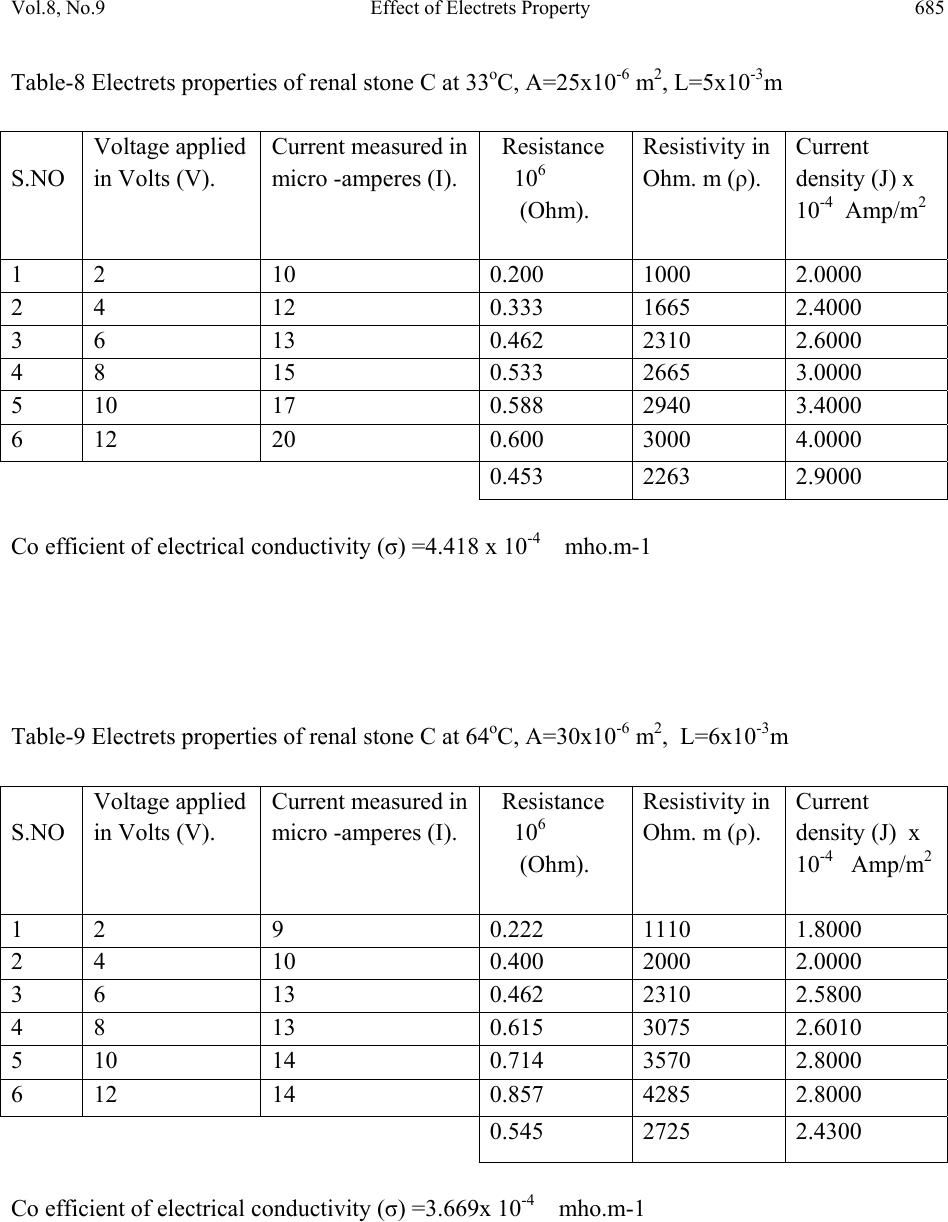 Vol.8, No.9 Effect of Electrets Property 685 Table-8 Electrets properties of renal stone C at 33oC, A=25x10-6 m2, L=5x10-3m S.NO Voltage applied in Volts (V). Current measured in micro -amperes (I). Resistance 106 (Ohm). Resistivity in Ohm. m (ρ). Current density (J) x 10-4 Amp/m2 1 2 10 0.200 1000 2.0000 2 4 12 0.333 1665 2.4000 3 6 13 0.462 2310 2.6000 4 8 15 0.533 2665 3.0000 5 10 17 0.588 2940 3.4000 6 12 20 0.600 3000 4.0000 0.453 2263 2.9000 Co efficient of electrical conductivity (σ) =4.418 x 10-4 mho.m-1 Table-9 Electrets properties of renal stone C at 64oC, A=30x10-6 m2, L=6x10-3m S.NO Voltage applied in Volts (V). Current measured in micro -amperes (I). Resistance 106 (Ohm). Resistivity in Ohm. m (ρ). Current density (J) x 10-4 Amp/m2 1 2 9 0.222 1110 1.8000 2 4 10 0.400 2000 2.0000 3 6 13 0.462 2310 2.5800 4 8 13 0.615 3075 2.6010 5 10 14 0.714 3570 2.8000 6 12 14 0.857 4285 2.8000 0.545 2725 2.4300 Co efficient of electrical conductivity (σ) =3.669x 10-4 mho.m-1 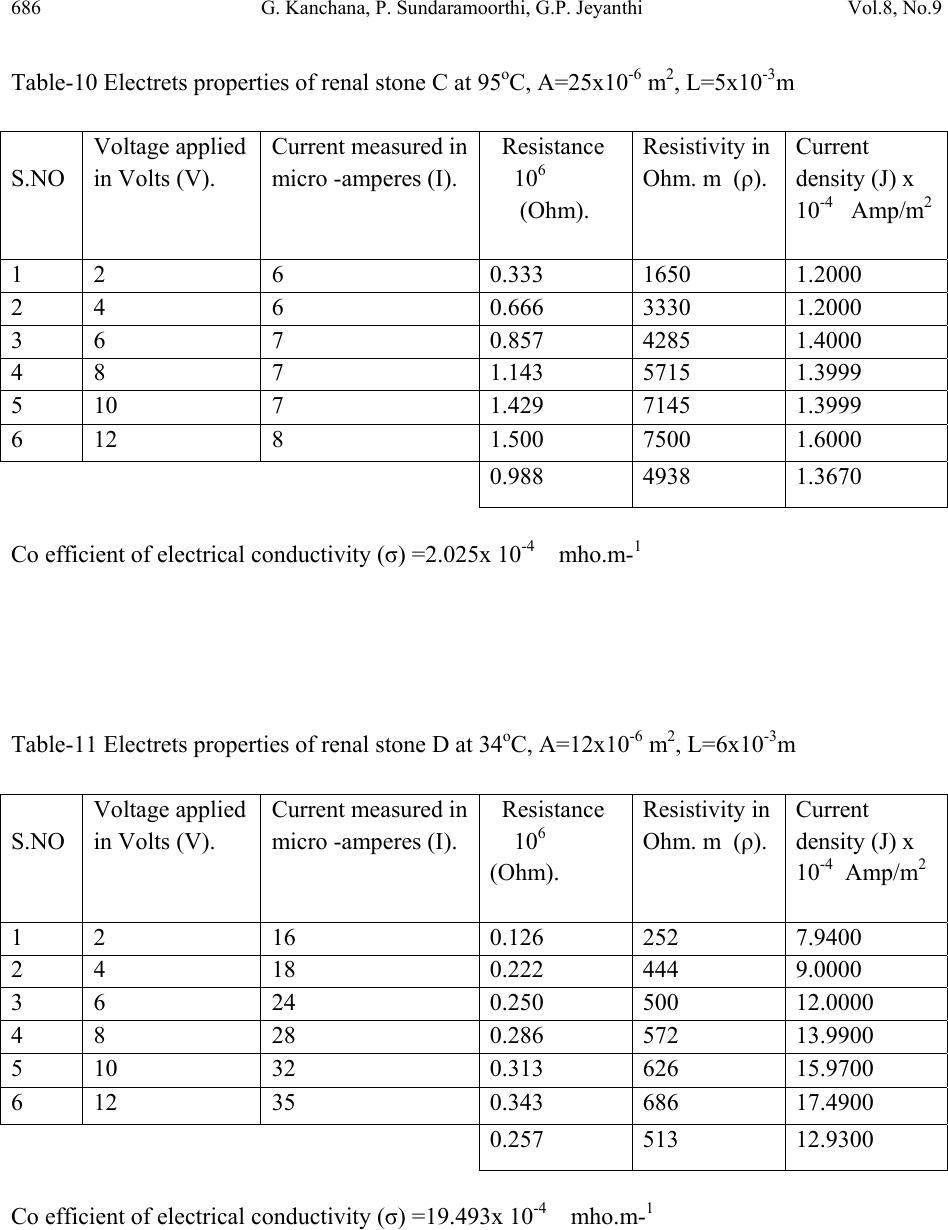 686 G. Kanchana, P. Sundaramoorthi, G.P. Jeyanthi Vol.8, No.9 Table-10 Electrets properties of renal stone C at 95oC, A=25x10-6 m2, L=5x10-3m S.NO Voltage applied in Volts (V). Current measured in micro -amperes (I). Resistance 106 (Ohm). Resistivity in Ohm. m (ρ). Current density (J) x 10-4 Amp/m2 1 2 6 0.333 1650 1.2000 2 4 6 0.666 3330 1.2000 3 6 7 0.857 4285 1.4000 4 8 7 1.143 5715 1.3999 5 10 7 1.429 7145 1.3999 6 12 8 1.500 7500 1.6000 0.988 4938 1.3670 Co efficient of electrical conductivity (σ) =2.025x 10-4 mho.m-1 Table-11 Electrets properties of renal stone D at 34oC, A=12x10-6 m2, L=6x10-3m S.NO Voltage applied in Volts (V). Current measured in micro -amperes (I). Resistance 106 (Ohm). Resistivity in Ohm. m (ρ). Current density (J) x 10-4 Amp/m2 1 2 16 0.126 252 7.9400 2 4 18 0.222 444 9.0000 3 6 24 0.250 500 12.0000 4 8 28 0.286 572 13.9900 5 10 32 0.313 626 15.9700 6 12 35 0.343 686 17.4900 0.257 513 12.9300 Co efficient of electrical conductivity (σ) =19.493x 10-4 mho.m-1 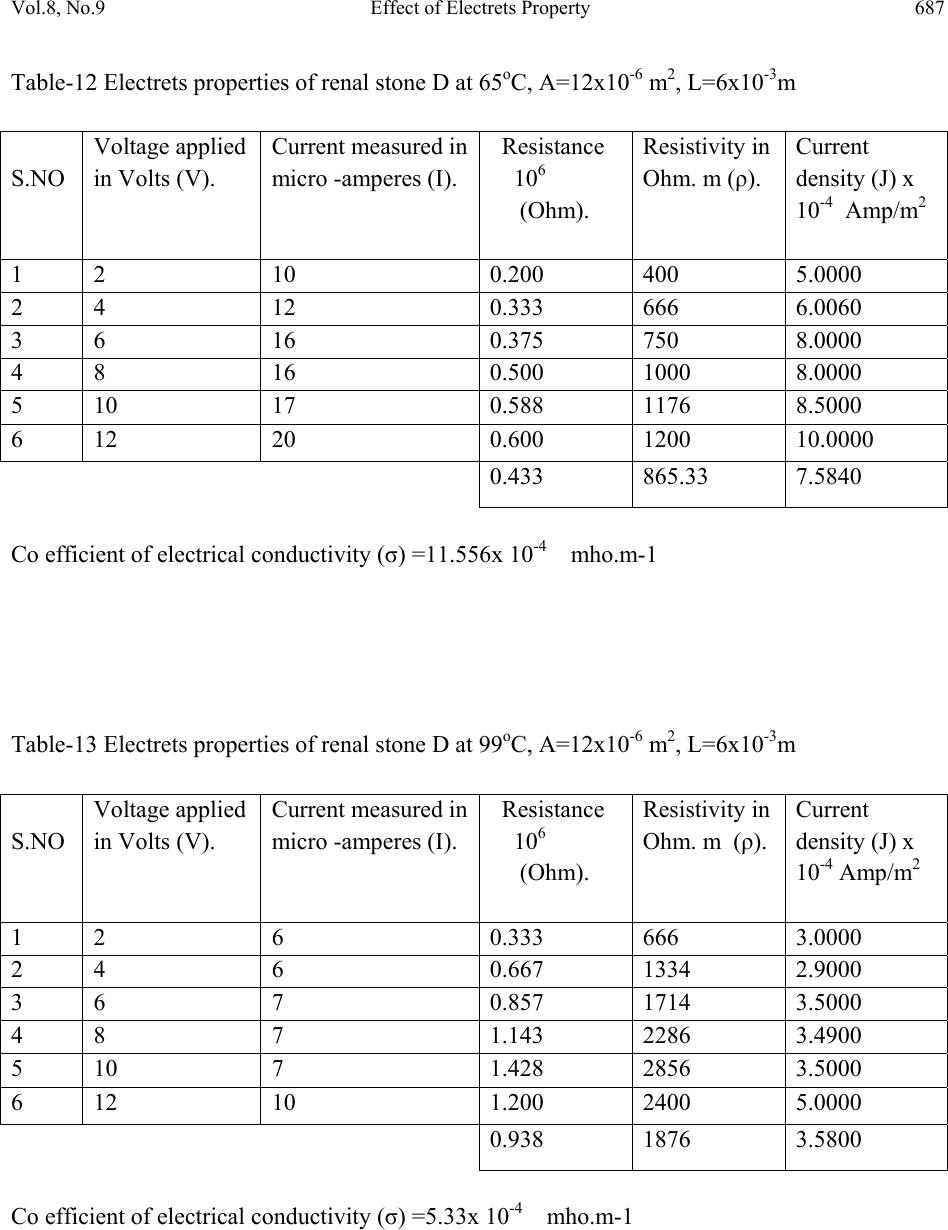 Vol.8, No.9 Effect of Electrets Property 687 Table-12 Electrets properties of renal stone D at 65oC, A=12x10-6 m2, L=6x10-3m S.NO Voltage applied in Volts (V). Current measured in micro -amperes (I). Resistance 106 (Ohm). Resistivity in Ohm. m (ρ). Current density (J) x 10-4 Amp/m2 1 2 10 0.200 400 5.0000 2 4 12 0.333 666 6.0060 3 6 16 0.375 750 8.0000 4 8 16 0.500 1000 8.0000 5 10 17 0.588 1176 8.5000 6 12 20 0.600 1200 10.0000 0.433 865.33 7.5840 Co efficient of electrical conductivity (σ) =11.556x 10-4 mho.m-1 Table-13 Electrets properties of renal stone D at 99oC, A=12x10-6 m2, L=6x10-3m S.NO Voltage applied in Volts (V). Current measured in micro -amperes (I). Resistance 106 (Ohm). Resistivity in Ohm. m (ρ). Current density (J) x 10-4 Amp/m2 1 2 6 0.333 666 3.0000 2 4 6 0.667 1334 2.9000 3 6 7 0.857 1714 3.5000 4 8 7 1.143 2286 3.4900 5 10 7 1.428 2856 3.5000 6 12 10 1.200 2400 5.0000 0.938 1876 3.5800 Co efficient of electrical conductivity (σ) =5.33x 10-4 mho.m-1 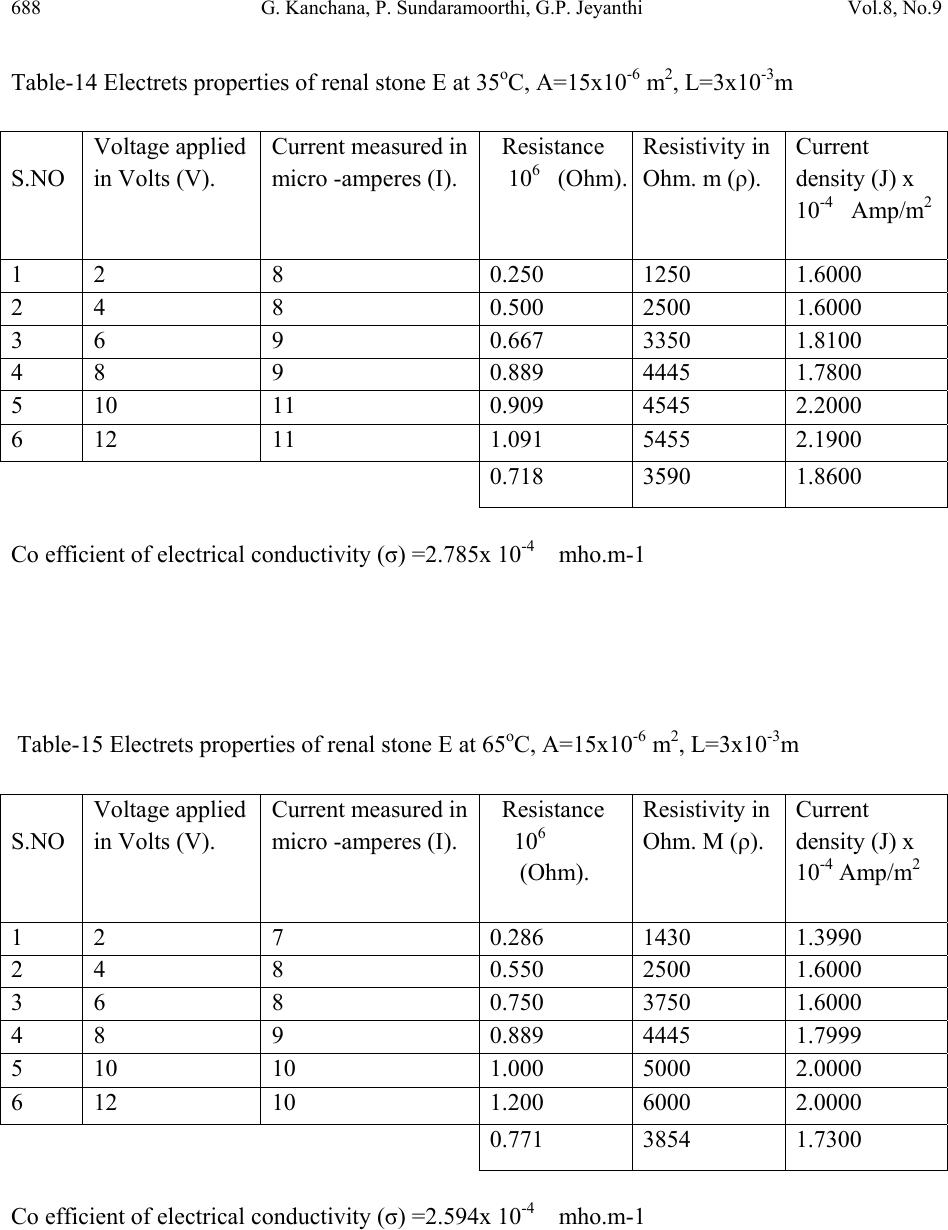 688 G. Kanchana, P. Sundaramoorthi, G.P. Jeyanthi Vol.8, No.9 Table-14 Electrets properties of renal stone E at 35oC, A=15x10-6 m2, L=3x10-3m S.NO Voltage applied in Volts (V). Current measured in micro -amperes (I). Resistance 106 (Ohm). Resistivity in Ohm. m (ρ). Current density (J) x 10-4 Amp/m2 1 2 8 0.250 1250 1.6000 2 4 8 0.500 2500 1.6000 3 6 9 0.667 3350 1.8100 4 8 9 0.889 4445 1.7800 5 10 11 0.909 4545 2.2000 6 12 11 1.091 5455 2.1900 0.718 3590 1.8600 Co efficient of electrical conductivity (σ) =2.785x 10-4 mho.m-1 Table-15 Electrets properties of renal stone E at 65oC, A=15x10-6 m2, L=3x10-3m S.NO Voltage applied in Volts (V). Current measured in micro -amperes (I). Resistance 106 (Ohm). Resistivity in Ohm. M (ρ). Current density (J) x 10-4 Amp/m2 1 2 7 0.286 1430 1.3990 2 4 8 0.550 2500 1.6000 3 6 8 0.750 3750 1.6000 4 8 9 0.889 4445 1.7999 5 10 10 1.000 5000 2.0000 6 12 10 1.200 6000 2.0000 0.771 3854 1.7300 Co efficient of electrical conductivity (σ) =2.594x 10-4 mho.m-1 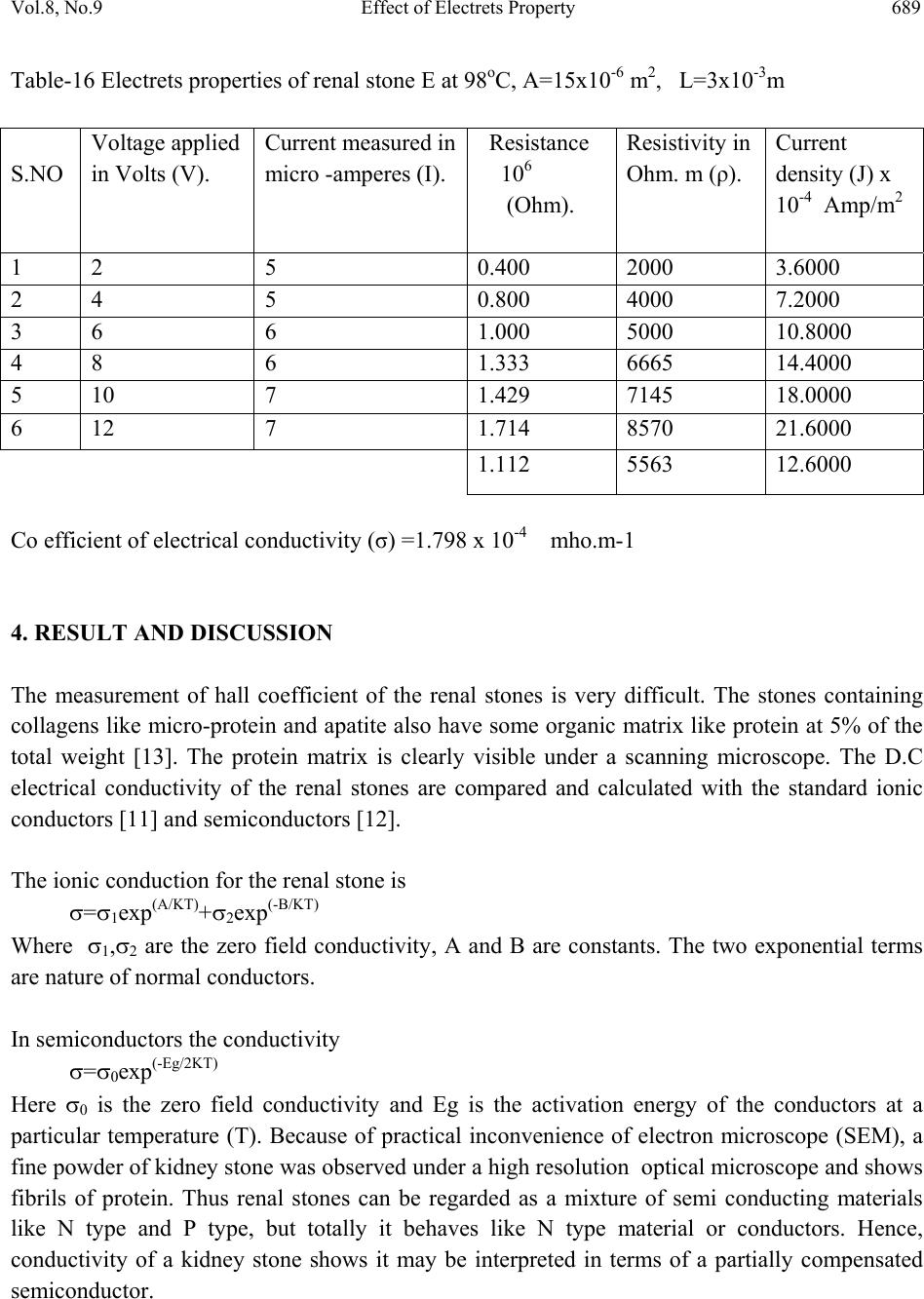 Vol.8, No.9 Effect of Electrets Property 689 Table-16 Electrets properties of renal stone E at 98oC, A=15x10-6 m2, L=3x10-3m S.NO Voltage applied in Volts (V). Current measured in micro -amperes (I). Resistance 106 (Ohm). Resistivity in Ohm. m (ρ). Current density (J) x 10-4 Amp/m2 1 2 5 0.400 2000 3.6000 2 4 5 0.800 4000 7.2000 3 6 6 1.000 5000 10.8000 4 8 6 1.333 6665 14.4000 5 10 7 1.429 7145 18.0000 6 12 7 1.714 8570 21.6000 1.112 5563 12.6000 Co efficient of electrical conductivity (σ) =1.798 x 10-4 mho.m-1 4. RESULT AND DISCUSSION The measurement of hall coefficient of the renal stones is very difficult. The stones containing collagens like micro-protein and apatite also have some organic matrix like protein at 5% of the total weight [13]. The protein matrix is clearly visible under a scanning microscope. The D.C electrical conductivity of the renal stones are compared and calculated with the standard ionic conductors [11] and semiconductors [12]. The ionic conduction for the renal stone is σ=σ1exp(A/KT)+σ2exp(-B/KT) Where σ1,σ2 are the zero field conductivity, A and B are constants. The two exponential terms are nature of normal conductors. In semiconductors the conductivity σ=σ0exp(-Eg/2KT) Here σ0 is the zero field conductivity and Eg is the activation energy of the conductors at a particular temperature (T). Because of practical inconvenience of electron microscope (SEM), a fine powder of kidney stone was observed under a high resolution optical microscope and shows fibrils of protein. Thus renal stones can be regarded as a mixture of semi conducting materials like N type and P type, but totally it behaves like N type material or conductors. Hence, conductivity of a kidney stone shows it may be interpreted in terms of a partially compensated semiconductor. 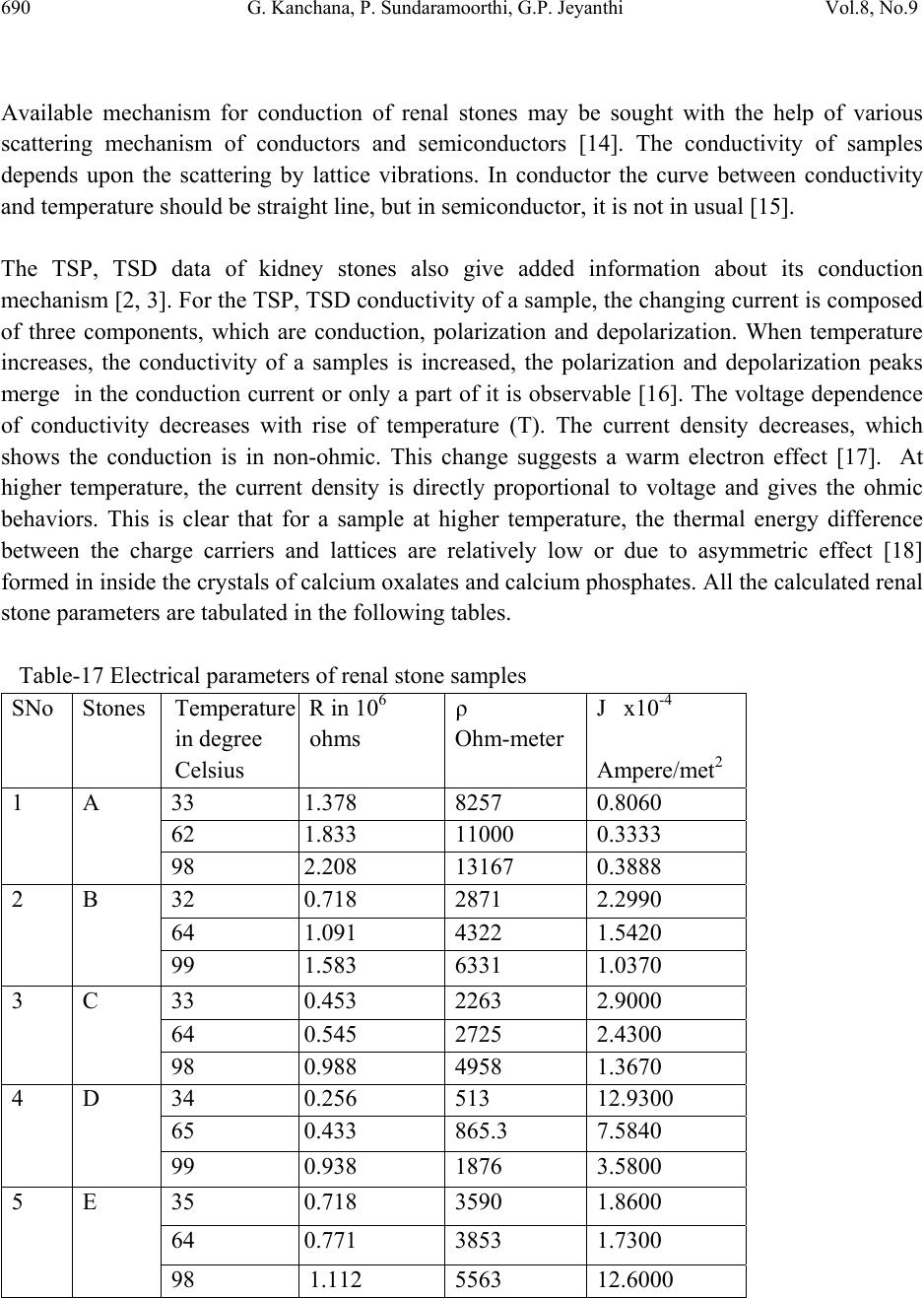 690 G. Kanchana, P. Sundaramoorthi, G.P. Jeyanthi Vol.8, No.9 Available mechanism for conduction of renal stones may be sought with the help of various scattering mechanism of conductors and semiconductors [14]. The conductivity of samples depends upon the scattering by lattice vibrations. In conductor the curve between conductivity and temperature should be straight line, but in semiconductor, it is not in usual [15]. The TSP, TSD data of kidney stones also give added information about its conduction mechanism [2, 3]. For the TSP, TSD conductivity of a sample, the changing current is composed of three components, which are conduction, polarization and depolarization. When temperature increases, the conductivity of a samples is increased, the polarization and depolarization peaks merge in the conduction current or only a part of it is observable [16]. The voltage dependence of conductivity decreases with rise of temperature (T). The current density decreases, which shows the conduction is in non-ohmic. This change suggests a warm electron effect [17]. At higher temperature, the current density is directly proportional to voltage and gives the ohmic behaviors. This is clear that for a sample at higher temperature, the thermal energy difference between the charge carriers and lattices are relatively low or due to asymmetric effect [18] formed in inside the crystals of calcium oxalates and calcium phosphates. All the calculated renal stone parameters are tabulated in the following tables. Table-17 Electrical parameters of renal stone samples SNo Stones Temperature in degree Celsius R in 106 ohms ρ Ohm-meter J x10-4 Ampere/met2 1 A 33 1.378 8257 0.8060 62 1.833 11000 0.3333 98 2.208 13167 0.3888 2 B 32 0.718 2871 2.2990 64 1.091 4322 1.5420 99 1.583 6331 1.0370 3 C 33 0.453 2263 2.9000 64 0.545 2725 2.4300 98 0.988 4958 1.3670 4 D 34 0.256 513 12.9300 65 0.433 865.3 7.5840 99 0.938 1876 3.5800 5 E 35 0.718 3590 1.8600 64 0.771 3853 1.7300 98 1.112 5563 12.6000 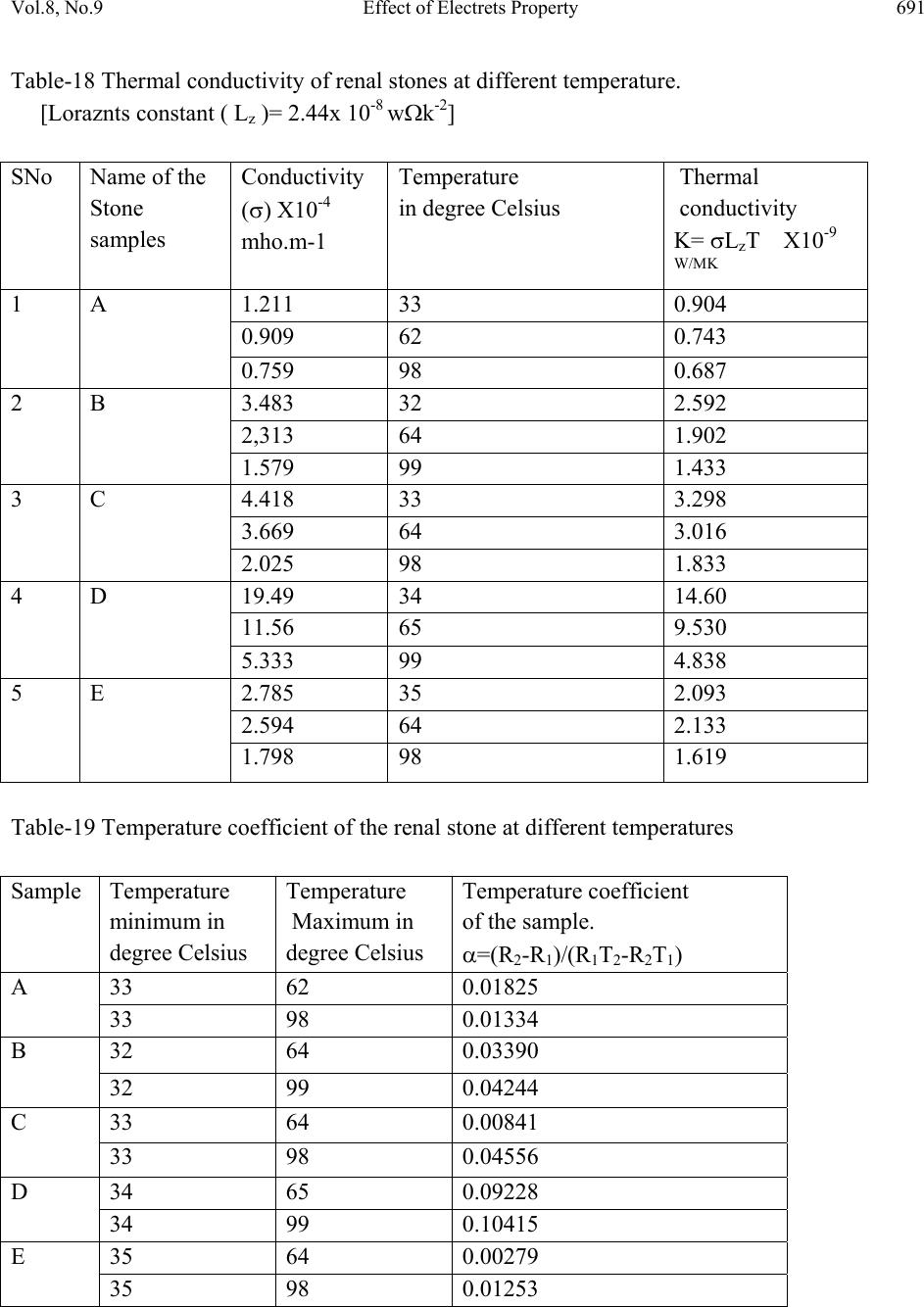 Vol.8, No.9 Effect of Electrets Property 691 Table-18 Thermal conductivity of renal stones at different temperature. [Loraznts constant ( Lz )= 2.44x 10-8 wΩk-2] SNo Name of the Stone samples Conductivity (σ) X10-4 mho.m-1 Temperature in degree Celsius Thermal conductivity K= σLzT X10-9 W/MK 1 A 1.211 33 0.904 0.909 62 0.743 0.759 98 0.687 2 B 3.483 32 2.592 2,313 64 1.902 1.579 99 1.433 3 C 4.418 33 3.298 3.669 64 3.016 2.025 98 1.833 4 D 19.49 34 14.60 11.56 65 9.530 5.333 99 4.838 5 E 2.785 35 2.093 2.594 64 2.133 1.798 98 1.619 Table-19 Temperature coefficient of the renal stone at different temperatures Sample Temperature minimum in degree Celsius Temperature Maximum in degree Celsius Temperature coefficient of the sample. α=(R2-R1)/(R1T2-R2T1) A 33 62 0.01825 33 98 0.01334 B 32 64 0.03390 32 99 0.04244 C 33 64 0.00841 33 98 0.04556 D 34 65 0.09228 34 99 0.10415 E 35 64 0.00279 35 98 0.01253 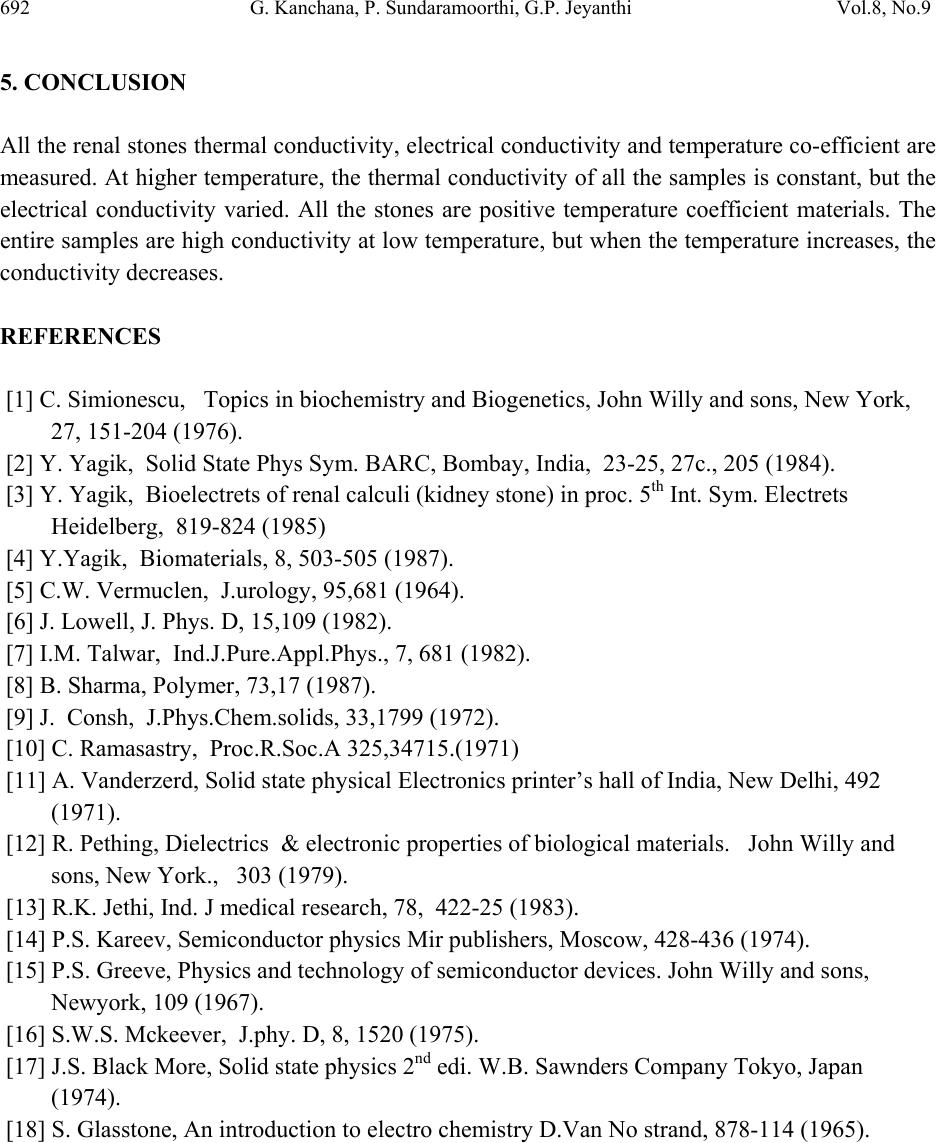 692 G. Kanchana, P. Sundaramoorthi, G.P. Jeyanthi Vol.8, No.9 5. CONCLUSION All the renal stones thermal conductivity, electrical conductivity and temperature co-efficient are measured. At higher temperature, the thermal conductivity of all the samples is constant, but the electrical conductivity varied. All the stones are positive temperature coefficient materials. The entire samples are high conductivity at low temperature, but when the temperature increases, the conductivity decreases. REFERENCES [1] C. Simionescu, Topics in biochemistry and Biogenetics, John Willy and sons, New York, 27, 151-204 (1976). [2] Y. Yagik, Solid State Phys Sym. BARC, Bombay, India, 23-25, 27c., 205 (1984). [3] Y. Yagik, Bioelectrets of renal calculi (kidney stone) in proc. 5th Int. Sym. Electrets Heidelberg, 819-824 (1985) [4] Y.Yagik, Biomaterials, 8, 503-505 (1987). [5] C.W. Vermuclen, J.urology, 95,681 (1964). [6] J. Lowell, J. Phys. D, 15,109 (1982). [7] I.M. Talwar, Ind.J.Pure.Appl.Phys., 7, 681 (1982). [8] B. Sharma, Polymer, 73,17 (1987). [9] J. Consh, J.Phys.Chem.solids, 33,1799 (1972). [10] C. Ramasastry, Proc.R.Soc.A 325,34715.(1971) [11] A. Vanderzerd, Solid state physical Electronics printer’s hall of India, New Delhi, 492 (1971). [12] R. Pething, Dielectrics & electronic properties of biological materials. John Willy and sons, New York., 303 (1979). [13] R.K. Jethi, Ind. J medical research, 78, 422-25 (1983). [14] P.S. Kareev, Semiconductor physics Mir publishers, Moscow, 428-436 (1974). [15] P.S. Greeve, Physics and technology of semiconductor devices. John Willy and sons, Newyork, 109 (1967). [16] S.W.S. Mckeever, J.phy. D, 8, 1520 (1975). [17] J.S. Black More, Solid state physics 2nd edi. W.B. Sawnders Company Tokyo, Japan (1974). [18] S. Glasstone, An introduction to electro chemistry D.Van No strand, 878-114 (1965). |

